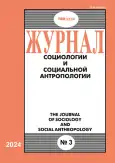The article focuses on explanatory schemes, research logic, heuristic capabilities of the online and offline correlation model of exclusion fields (E. Helsper), as well as the continuum model of social and digital inequality, profiling risk groups of digital exclusion (I. Mariën, L. Van Audenhove, A. Asmar) in the explication of the digital divide three-level construct. It is shown that modern studies of digital inclusion are based on the classical sociological conceptualizations of inequality (A. Giddens, P. Bourdieu), the capabilities approach (A. Sen), the intersectional theory (K. Crenshaw). The models of E. Helsper and Belgian researchers are based on the idea of the relationship between social and digital isolation, the reinterpretation of the Bourdieusian categories of "field", "resource", "capital". According to E. Helsper, the fields of exclusion are differentiated by the amount of resources, they are autonomous, but interconnected, they frame individual actions. The operationalization of the concept of personal resources into an analytical model of exclusion fields allows E. Helsper to take into account the freedom of choice of an individual in the construction of online practices. Socio-digital inequality is characterized as the inequality in digital resources and opportunities. The E. Helsper model is based on A. Giddens' theory of structuration in understanding the relationship between sociotechnical structure and user action. The heuristic potential of the capabilities approach in the explanation of digital inclusion is revealed. The Belgian model is based on the analytical construct of E. Helsper, focusing on the identification of exclusion risk factors relevant to the resources of the individual. The digital divide is interpreted as a continuum, a range of positions on a scale from deep exclusion to deep inclusion. In the model of I. Marien and co-authors, eight profiles of (non)users are identified, social and digital predictors of inequality are identified, the dynamism and procedural nature of digital integration and isolation are emphasized. The model shows that socially and economically vulnerable groups can be active users of online technologies. The differences between continuum model of the social and digital inequality and the conceptual construct of E. Helsper are revealed: instead of mutual influence mediators of online and offline fields of exclusion, indicators of isolation risk are proposed, direct and indirect cause and effect relationships between the determinants of social and digital exclusion are established. It was concluded that it is expedient to use models in the study of digital divide third level.
 7-38
7-38


 39-64
39-64


 65-105
65-105


 106-145
106-145


 146-167
146-167


 168-195
168-195


 196-215
196-215


 216-249
216-249


 250-261
250-261










